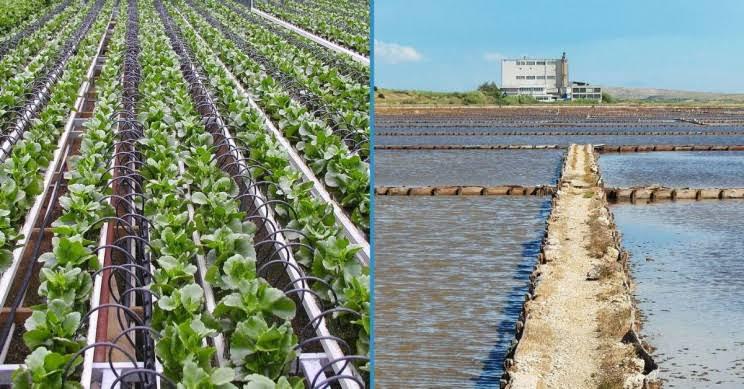The Chinese Ministry of Agriculture and Rural Affairs announced on Thursday that the country is ramping up its efforts to prevent drought and ensure a successful summer grain and oil harvest. This move comes as a response to the growing concern over the damages caused by droughts in recent years.
Droughts can cause significant damage to crops, resulting in lower yields and even complete crop failures. In addition to the agricultural sector, droughts can also impact the economy, as farmers struggle to make ends meet and food prices rise.
To combat the effects of droughts, the Ministry of Agriculture and Rural Affairs has issued a plan that requires all localities to implement preventive measures in advance. This plan aims to ensure that there is enough water for crop irrigation, even in areas prone to drought.
The plan also includes the use of advanced technologies to monitor soil moisture levels and predict weather patterns. This information can help farmers make more informed decisions about planting and irrigation, which can improve crop yields and reduce water usage.
In addition to these preventive measures, the Chinese government is also investing in infrastructure to increase water storage and distribution. This includes building new reservoirs and canals, as well as upgrading existing water systems to make them more efficient and sustainable.
The plan issued by the Ministry of Agriculture and Rural Affairs demonstrates the Chinese government’s commitment to addressing the growing concern over droughts. By taking proactive steps to prevent and mitigate the effects of droughts, the country is working to ensure a stable food supply and a thriving agricultural sector.
Low precipitation in China since the winter of 2022 has led to concerns over the possibility of drought in some areas this spring. This could result in severe difficulties for the harvest of grain and oil in the summer. It is critical to take preventative measures in advance to mitigate the negative effects of drought.
The consequences of drought can be severe. Lack of rainfall can reduce crop yields, and in extreme cases, it can lead to crop failure. Drought can also impact the livelihoods of farmers, as well as causing shortages of food and water. It can also have negative impacts on ecosystems, leading to soil erosion, desertification, and reduced biodiversity.
To address the issue of drought, the Ministry of Agriculture and Rural Affairs has issued a plan that urges all localities to implement early preventive measures to promote the normal growth of wheat and oilseed rape. These measures could include improved irrigation systems, the use of drought-tolerant crops, and better management of water resources.
One important factor in preventing drought is efficient water management. In areas where water is scarce, it is essential to use it carefully and efficiently. This could involve the construction of irrigation systems that maximize the use of available water or encouraging the use of drought-resistant crops that require less water. Additionally, there may be opportunities to increase water availability by improving water capture and storage systems, such as building dams or reservoirs.
Another way to mitigate the effects of drought is to encourage sustainable farming practices. This could include measures such as crop rotation, cover cropping, and conservation tillage, which help to improve soil health and reduce water loss. Additionally, farmers can be encouraged to use techniques such as intercropping, which involves growing two or more crops together, to improve water retention and reduce the risk of crop failure.
Drought is a natural disaster that poses severe threats to people’s lives and livelihoods. In times of drought, water sources become scarce, and crops wither away, leading to food shortages and economic losses. Therefore, drought relief water sources play a critical role in ensuring the survival of people and their livestock.
To address this issue, the plan emphasizes the need to reserve drought relief water sources. These sources could be in the form of reservoirs, wells, or other water storage facilities that can be used during times of drought. By reserving these sources, communities can better manage and conserve water during drought periods, ensuring that everyone has access to clean and safe drinking water.
In addition to reserving drought relief water sources, the plan calls for the timely repair and building of water conservancy facilities. This is important because water conservation is crucial to ensuring water sustainability during drought periods. These facilities could include dams, irrigation systems, and other structures that help conserve water and improve its distribution. By investing in these facilities, communities can better manage their water resources, reducing the impact of drought on their lives and livelihoods.
Furthermore, the plan highlights the importance of stockpiling and distributing supplies for agricultural production, such as seeds and fertilizers. During drought periods, agriculture is one of the sectors that are most affected. By ensuring that there are sufficient supplies of agricultural inputs, farmers can continue to produce crops, even during times of drought. This helps to ensure food security, reduce economic losses, and improve the resilience of rural communities.
In conclusion, drought relief water sources, timely repair and building of water conservancy facilities, and stockpiling and distributing supplies for agricultural production are all critical measures for addressing the impact of drought. By investing in these measures, communities can better manage water resources, reduce the impact of drought on their lives and livelihoods, and improve their resilience in the face of natural disasters.
Read More:
